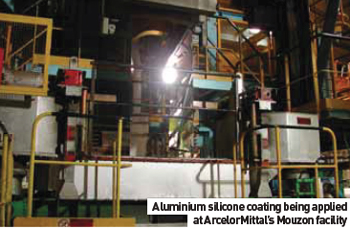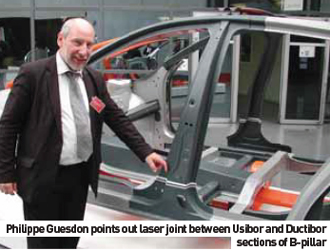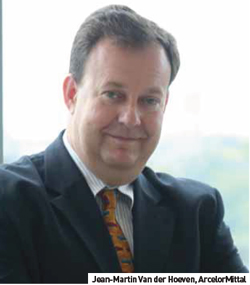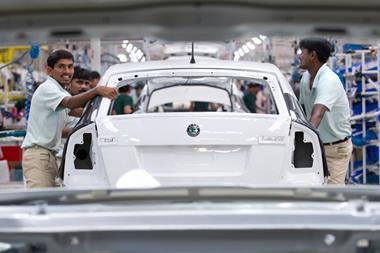
As crash legislation tightens and the drive for lower-mass body structures continues to grow, so steel producers are rising to the challenge
ArcelorMittal’s S-in motion project was first rolled out to customers in November 2010, an ‘intensive’ effort to meet the current and future requirements surrounding production of electric vehicles while developing innovative, cost-effective coatings for a new generation of hot stamping materials. These will include high-strength steels with high formability qualities.
A study conducted by AM has identified about 43 parts used in production of a typical C-segment vehicle that could benefit from being made from specialist steels. With the goal of reducing total vehicle weight, cutting costs and helping to manufacture more sustainable, stronger and safer vehicles, all of the solutions are suitable for use with vehicles that are currently in production.
In fact, for most of the 43 parts, more than one solution has been identified, which has led to the release of a catalogue of more than 60 solutions utilizing a range of different press-hardened (PHS) and advanced high-strength steels (AHSS), as well as stainless steel (typically 17.7C- 1.4310 for the A-pillar lower outer) and long products (such as CRS2050 for the spring and forged SOLAMB1100, used in steering knuckle fabrication). Manufacturers implementing the lightest solution for each part could save up to 19% of a typical vehicle’s overall weight based on comparisons with a baseline C-segment vehicle.
 Part of the Usibor solution, described as ‘helping carmakers save time and reduce costs’, is an aluminium-silicone coating that is applied to steel coil. This is claimed to allow better ‘pressability’, while preventing corrosion of the blank before and after the hot stamping process.
Part of the Usibor solution, described as ‘helping carmakers save time and reduce costs’, is an aluminium-silicone coating that is applied to steel coil. This is claimed to allow better ‘pressability’, while preventing corrosion of the blank before and after the hot stamping process.
Tailored solutions for better crashability
Approximately 35% of the body-in-white (BIW) of a baseline C-segment vehicle is made up of press-hardened steels (PHS) and advanced high-strength steels (AHSS). Of this, PHS accounts for just 6% of the baseline BIW. In the optimised S-in motion solution, PHS and AHSS account for 54% of total bodyshell weight. While the level of AHSS has remained almost constant, the amount of PHS in the vehicle has increased to 25%.
The study further identified 29 parts of the S-in motion vehicle that could be made with hot-stamped Usibor 1500P steel. Cold- and hot-stamped laser-welded blanks (LWB) were identified as a solution for 24 of these parts, the Usibor product specifically developed by AM for hot stamping. At 1,500 MPa, Usibor is one of the strongest steels used in automotive applications today, returning excellent performance in forming, joining and corrosion resistance. ArcelorMittal holds a number of patents for combining LWB and hot stamping, which allow significant weight savings.
For example, B-pillars can be produced with a high level of strength in the upper part, but a lower level of strength in the bottom part of the pillar. This enables controlled deformation in crash conditions, yet saves between 20 and 25% of the weight of a typical B-pillar. Yet S-in motion is not just about cutting overall vehicle weight, the identified solutions also verified as safe, strong, and sustainable. As well as a Life Cycle Assessment, dent, crash and stiffness assessments were also performed. Forming and assembly simulations and risk assessments were carried out before the industrial forming and assembly sequences were validated.
ArcelorMittal was formed in 2006 following the acquisition of Arcelor (then the second-largest steel producer in the world in terms of production) by Mittal Steel. ArcelorMittal now claims to be the world’s leading steel company. In 2009, the company’s 282,000 employees generated revenues of $65.1bn. Crude steel production of 73.2 million tonnes saw the company account for approximately 8% of the world’s steel production.
ArcelorMittal’s activities in the automotive industry generated revenues of $9.4bn in 2009. Flat steel deliveries of 9.8 million tonnes and 6.1 million tonnes of coated steel products gave ArcelorMittal a global market share in that year of 19%. In 2010, the company claims to have supplied 21% of the world’s automotive steel.
The ArcelorMittal division which delivers the largest quantity of steel to the automotive industry is the Flat Carbon division. With operations in Europe and North America, the Flat Carbon section has approximately 88,000 employees, equivalent to 31.3% of the company’s entire workforce.
In Europe, ArcelorMittal has 23 automotive coating lines in Belgium and Luxembourg, Estonia, France, Germany, Spain and Turkey, including 19 hot-dip galvanized lines and four electrogalvanized lines. In North America, the company boasts 14 automotive coating lines, 11 of which are hot-dip galvanized lines. One galvanizing line, one aluminizing line and one electrogalvanizing line account for the remaining three lines. In South America, the company has two facilities in Brazil – a single cold-strip mill and coating facility, and a steel works and hot strip mill, and in South Africa, AM has an electrogalvanizing line and a steel works.
In terms of tubular products and tailored blanks, ArcelorMittal has facilities within the NAFTA (North American free-trade area), Western and Eastern Europe and Turkey. In South America and Asia, the company produces tailored blanks through local partnerships.
ArcelorMittal claims that its PHS and AHSS products can considerably reduce part springback. While those familiar with the industry will be aware of the various methods used to control springback, they may not fully understand the implications surrounding usage of this new range of high-strength steels and how these can remove the need for treating the root causes of springback. In the past, allowances have had to be made in die design, stamping process and part geometry to compensate for springback.
All these allowances can mean making unacceptable compromises in the crash performance of parts such as a vehicle side pillar, the use of thicker gauges to avoid distortion simply increasing overall weight and reducing vehicle performance – a situation that goes against the need to cut weight in order to meet ever-more stringent emissions legislation and fuel economy targets. Employing such forming strategies as darts, bird beaks and stiffening beads to try and negate the effects of springback, is to treat the symptoms rather than the cause, as is the use of restrike dies to correct what is often a symptom of the material properties and not always a fault of die or component design.
At AM’s Montataire R&D centre, Philippe Guesdon, Program Leader, Design of Automotive Structure, sums up the advantages of the Usibor material and its application in automotive BIW: “This produces a very lightweight vehicle bodyside. Many parts are made from Usibor, a high boron steel, with a coating of aluminium silicone. This is not only for anti-corrosion in general; it is mainly to prevent oxidation during the hot stamping process.”
According to Guesdon, this removes the need for phosphating; after stamping, it can be immediately primered. The B-pillar blank is laser welded, with a Usibor section at the top to protect the occupants and maintain the integrity of the safety cell structure. In the lower section, the more ductile steel, Ductibor, is used to absorb energy in the event of a side impact. “Traditionally it has been very difficult to achieve a lower strength at the base (of a B-pillar) and high strength where you need it, in the upper section.
In the past, this has been achieved with pieces of different thicknesses, welded together after stamping. “Often, when you have a very high-grade steel and try to form complex shapes by cold forming, you need very high pressures and can have many problems with springback.
Using Ductibor, the deformable part of this B-pillar can be formed more easily. Essentially, Ductibor is a high-grade steel formulated for easier cold stamping.”
AMS spoke with Michel Wurth, member of the Group Management Board at ArcelorMittal’s Luxembourg headquarters.
AMS: As the global price of steel has become increasingly volatile and OEM demand for steel declined due to the recession, how has the contract situation changed for steelmakers like AM?
 Michel Wurth: Contracts have changed, now we have contracts written from January 1, March 1, April 1, and so on. We will have certain contracts that will be under negotiation on a much shorter timescale than the annual agreements of the past. There is a more general trend, that the OEMs are looking for an ‘indexation’ of prices for six months and not for the 12 months of former times. We will work to control cost but we cannot absorb too much increase in the base stock prices.
Michel Wurth: Contracts have changed, now we have contracts written from January 1, March 1, April 1, and so on. We will have certain contracts that will be under negotiation on a much shorter timescale than the annual agreements of the past. There is a more general trend, that the OEMs are looking for an ‘indexation’ of prices for six months and not for the 12 months of former times. We will work to control cost but we cannot absorb too much increase in the base stock prices.
AMS: Given the volatility of the steel market, are some of your OEM customers, who are ramping up volumes in places such as India and China, buying larger quantities to try and ‘hedge’ their positions?
MW: With the automotive market, just-in-time delivery ‘habits’ tend to remain. For example, we have one customer we recently visited at their European plant; total inventory is only three coils. We are supplying them three times a day.
AMS: So should OEMs look to shorten their contracts with steelmakers like yourselves, down to only three months?
MW: We say that we can supply our customers, with a good visibility of future pricing, up to six months. Beyond that time, we have to ‘work in’ the volatility risk of the market. If you look at one car, typically 600kg of steel, you might buy one tonne of steel for producing this 600 kg car and the value of the scrap helps with the changing prices. Ultimately, the price of the steel content, as compared to the overall cost of the car, is not so significant.
AMS: Are you seeing much more intelligent use of scrap than in the past?
MW: There is not one model for recycling, whether it comes back to us or is recycled elsewhere is very much a matter of logistics. We must offer our customers the flexibility to recycle where and with whom they want.
AMS: With the higher strength and application-specific nature of Usibor and other high-strength steels, are you seeing less steel going into each car?
 MW: We want to sell value to the OEM. With Usibor, we are able to explain to our customers that we give them a huge additional value. This makes negotiations easier; the customer has to buy less quantity and it is much easier to come to a pricing agreement than if you have to say simply we need to have 10% more [price for each coil] and the purchaser says, “My boss told me to buy steel at 10% cheaper.” The added value of products like Usibor will help us to remain competitive, but of course, the R&D cost of developing these products has to be paid for. The steel industry has not been particularly innovative compared to many other sectors.
MW: We want to sell value to the OEM. With Usibor, we are able to explain to our customers that we give them a huge additional value. This makes negotiations easier; the customer has to buy less quantity and it is much easier to come to a pricing agreement than if you have to say simply we need to have 10% more [price for each coil] and the purchaser says, “My boss told me to buy steel at 10% cheaper.” The added value of products like Usibor will help us to remain competitive, but of course, the R&D cost of developing these products has to be paid for. The steel industry has not been particularly innovative compared to many other sectors.
AMS: Is this type of innovation going to be the method by which steel remains the material of choice for automotive production, negating the threat [much mooted in the 1980s and 1990s] of the all-aluminium car?
MW: Yes, thanks to the innovations of the industry as a whole, steel has remained the major material for car bodies.
There were two main directions during the 1990s; the first was the corrosion issue, steel cars will rust if not properly treated, and the second point is that we can make steel bodies much safer. In the 1990s, we did a lot of work with the OEMs making smaller vehicles, particularly the French carmakers. When the NCAP tests came in, the OEMs responded very aggressively; we quickly had Renaults and Peugeots that were as safe or safer than the big Volvos of the time.
AMS: With hot stamping and press-hardened steels, the OEMs (or their body parts suppliers) are doing some of the hardening of the steel that formerly might have been done by yourselves. What is your take on this view?
MW: This comment is relevant, but the laws of physics are such that to get the deep draw shapes that OEMs design into their cars, they have to hot stamp and we have to leave this part of the operation to the carmaker, who has the core competence for this process.

AMS: With the over-capacity of car plants and even suppliers in Europe, is high-strength steel adding to the competitive situation?
MW: I think that the (high-strength) products that we are offering are strengthening the competitive nature of the European car industry. More important than the overautomotive capacity situation is the technological leadership of the suppliers. I really think that the European car industry has one of the best industrial value chains in any industry.
 AMS also talked to Jean-Martin van der Hoeven, Chief Marketing Officer, Automotive Europe at ArcelorMittal about the company’s global footprint, delivery of specialty steels and how these products will fit into future vehicle programmes.
AMS also talked to Jean-Martin van der Hoeven, Chief Marketing Officer, Automotive Europe at ArcelorMittal about the company’s global footprint, delivery of specialty steels and how these products will fit into future vehicle programmes.
AMS: Have you noticed a shift in your automotive orders away from established markets like Europe and NAFTA, towards the emerging markets?
Jean-Martin Van Der Hoeven: In the Western hemisphere, we supply to all the major vehicle manufacturers and many Tier 1 suppliers. Many of them have operations set up or now starting in emerging markets like China, India, Brazil and Russia, and we service their needs, initially by supplying them from our existing bases, such as Western Europe or North and South America. In some of the emerging regions, we are planning to establish local direct supply.
AW: China has an established a low-cost base steel industry. How can you be competitive there, considering their reduced production costs?
JMV: For the specialized steel products that OEMs are now demanding, and that we make, there is little or no competition from Chinese domestic steelmakers. Examples of these products are organic coated material and specialty products like coated boron steel for hot stamping. Where these are required by an incoming OEM, we will supply to them in the new region. And of course, Chinese carmakers will need to continue to improve their vehicles’ crash performance in NCAP and similar tests if they are to effectively market to the rest of the world. This is where ArcelorMittal can help, while continuing to expand its global footprint.
AW: When you move production into a new market, do you have to include a certain amount of local content or make a joint-venture to operate there?
JMV: As long as the product is not already available locally, we do not usually have to enter into any form of joint venture. Governments in many regions do require a certain level of local content in each vehicle, and as mild steels are used for at least a small portion of the vehicle, local steel companies still have some input and thus create some jobs. AMS: How do you see the development of pure electric, hybrid and lightweight vehicles, and the increased usage of aluminium, plastics, composites, etc., affecting the global automotive steel market?
JMV: The popular predictions are that by 2015, up to 95% of the metal material used in BIW will be steel. An erroneous perception has emerged that lighter autos and reduced emissions are primarily associated with the application of low-density materials, like aluminium, magnesium and plastics. The use of aluminium in a car, however, remains rare, it is not easy to recycle and you also have to take into account the lifecycle analysis. To produce one tonne of aluminium, you produce six to seven times more CO2 than to produce the same amount of steel. Composite construction will only have a small share in the automotive industry for some time to come.




































